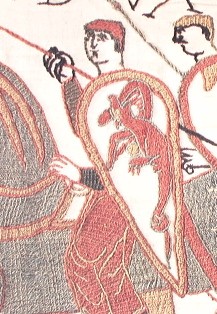Norman shield: Difference between revisions
m (Reverted edit of Tiff, changed back to last version by Simoncursitor) |
(Re-edited to accommodate Tiff's comments -- assuing this is what s/he wanted to say) |
||
| Line 5: | Line 5: | ||
The design is good for vertical cover and (if strapped to the arm correctly) can quite easily be manoevered to meet leg attacks. It is, however, quite a heavy design, and needs a good strong arm. |
The design is good for vertical cover and (if strapped to the arm correctly) can quite easily be manoevered to meet leg attacks. It is, however, quite a heavy design, and needs a good strong arm. |
||
It should be noted that the gent in the picture has the shield slung at his shoulder, rather than gripped for combat.<br>It is not known now the extant to which |
It should be noted that the gent in the picture has the shield slung at his shoulder, rather than gripped for combat.<br>It is not known now the extant to which shields of this type and period actually were decorated (although other contemporary sources appear to indicate that they were), nor whether any decoration was a proto-example of personal heraldry, an indication of allegiance amongst different bands fighting together, or the artistic choice of the crafters who made the shields. |
||
[[category:shield]] |
[[category:shield]] |
||
Revision as of 18:34, 12 April 2005
The Norman shield was used by the Normans from the 11th to 15th centuries. It is a large shield, often referred to as a kite shield because of its shape.
The design is good for vertical cover and (if strapped to the arm correctly) can quite easily be manoevered to meet leg attacks. It is, however, quite a heavy design, and needs a good strong arm.
It should be noted that the gent in the picture has the shield slung at his shoulder, rather than gripped for combat.
It is not known now the extant to which shields of this type and period actually were decorated (although other contemporary sources appear to indicate that they were), nor whether any decoration was a proto-example of personal heraldry, an indication of allegiance amongst different bands fighting together, or the artistic choice of the crafters who made the shields.
